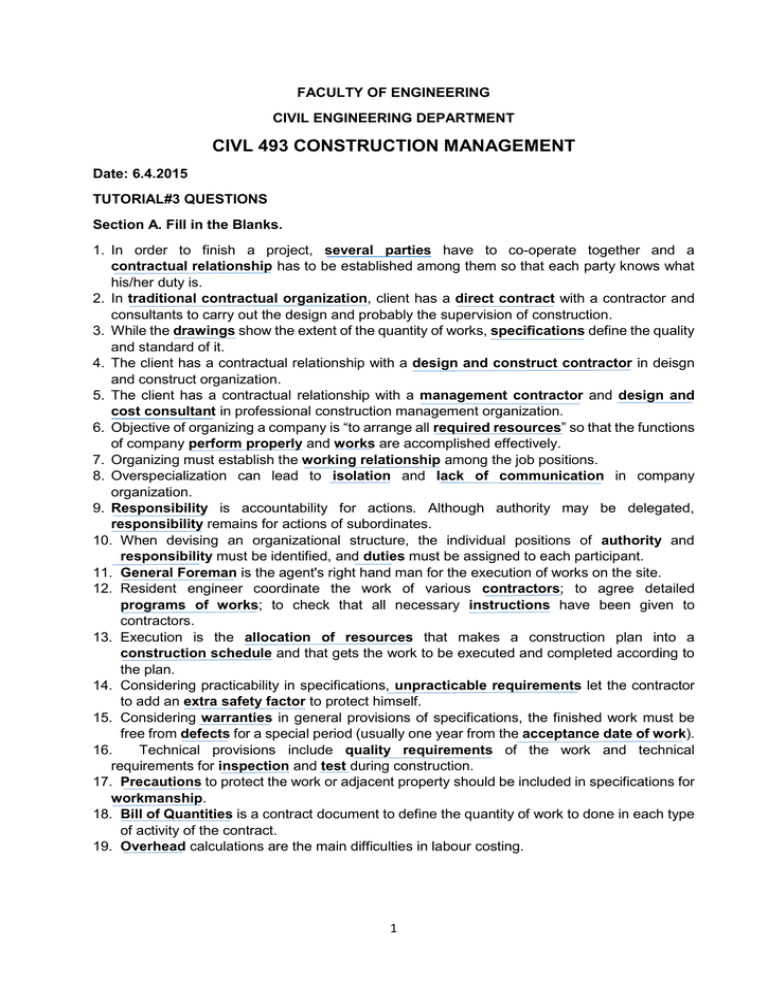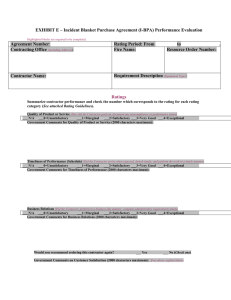civl 493 construction management
advertisement

FACULTY OF ENGINEERING CIVIL ENGINEERING DEPARTMENT CIVL 493 CONSTRUCTION MANAGEMENT Date: 6.4.2015 TUTORIAL#3 QUESTIONS Section A. Fill in the Blanks. 1. In order to finish a project, several parties have to co-operate together and a contractual relationship has to be established among them so that each party knows what his/her duty is. 2. In traditional contractual organization, client has a direct contract with a contractor and consultants to carry out the design and probably the supervision of construction. 3. While the drawings show the extent of the quantity of works, specifications define the quality and standard of it. 4. The client has a contractual relationship with a design and construct contractor in deisgn and construct organization. 5. The client has a contractual relationship with a management contractor and design and cost consultant in professional construction management organization. 6. Objective of organizing a company is “to arrange all required resources” so that the functions of company perform properly and works are accomplished effectively. 7. Organizing must establish the working relationship among the job positions. 8. Overspecialization can lead to isolation and lack of communication in company organization. 9. Responsibility is accountability for actions. Although authority may be delegated, responsibility remains for actions of subordinates. 10. When devising an organizational structure, the individual positions of authority and responsibility must be identified, and duties must be assigned to each participant. 11. General Foreman is the agent's right hand man for the execution of works on the site. 12. Resident engineer coordinate the work of various contractors; to agree detailed programs of works; to check that all necessary instructions have been given to contractors. 13. Execution is the allocation of resources that makes a construction plan into a construction schedule and that gets the work to be executed and completed according to the plan. 14. Considering practicability in specifications, unpracticable requirements let the contractor to add an extra safety factor to protect himself. 15. Considering warranties in general provisions of specifications, the finished work must be free from defects for a special period (usually one year from the acceptance date of work). 16. Technical provisions include quality requirements of the work and technical requirements for inspection and test during construction. 17. Precautions to protect the work or adjacent property should be included in specifications for workmanship. 18. Bill of Quantities is a contract document to define the quantity of work to done in each type of activity of the contract. 19. Overhead calculations are the main difficulties in labour costing. 1 Section B. True or False 1. In briefing stage, user requirements, locations and site conditions, planning, designing, estimated costs, quality requirements are considered. T or F. 2. In briefing stage, the project team is normally headed by a project coordinator, who is responsible to the client for the execution of the project. T or F. 3. In tendering stage, in the case of government projects, the project management team may be expected to give technical support by providing the necessary contract documents. T or F. 4. In construction stage, the project manager and his team must arrange for adequate supervision of the work to ensure requirements. T or F. 5. The Site Engineer checks that works are constructed to the right lines and levels. T or F. 6. In Unit Price contracts, plans & specifications need to be completed in detail. T or F. 7. When there is uncertainty to exact cost of the construction, negotiated contracts (Cost+contracts) are useful. T or F. 8. Contractor will tend to pull up the cost of the work to increase his fee - owner has a great risk in “Cost+percentage cost” contracts. T or F. 9. Contract is incentive for the contractor to reduce the cost in “Cost+fixed fee” contracts. T or F. 10. In “Cost + Fixed Fee + Contract with a profit sharing” contracts, there will be an increase in the profit of contractor if he increases the estimated cost. T or F. 11. In Cost + Guaranteed Ceiling Price” contracts, contractor guaranties that the cost of construction will not exceed a maximum. T or F. 12. Fixed price, unit price or negotiated contracts will be used in professional construction management organization. T or F. Section C. Answer the following questions. 1. 2. 3. 4. 5. 6. 7. 8. 9. 10. 11. 12. 13. 14. 15. 16. 17. 18. 19. 20. 21. 22. Explain what are the main characteristics of a construction project and type of projects in the construction industry? Illustrate and explain what are the elements of Project Management? Illustrate how is the managerial cycle in a construction project? What are the objectives of a project in planning stage? What is the aim of establishing a project control system? What are the activities included in design stage? Explain what is an organizational chart? Explain what are the two predominant aspects of most organization charts? What are the advantages of the functional organization structure? What are the disadvantages of the pure project organization structure? What are the advantages of matrix organization structure? Illustrate and explain the matrix organization structure in a construction company. What are objectives of Project Management Team (planners, administrators, supervisors)? In appointing project manager, which factors client will consider? In a construction site which factors do the agent’s power depends on? What are the duties of the resident engineer? If a client is lacking certain skills or does not have experience in the construction, explain which issues the client will need to obtain advice from the consultant. What are project delivery methods used in construction? What are the factors to be considered for selecting a project delivery system? Describe the conditions when the lump sum contracts are good to use. Explain what are the types of negotiated contracts? Explain what are the sources of controversy in Cost + Contracts? 2 23. 24. 25. 26. What type of documents do a construction contract comprise? What are the factors to be considered for selecting a contractor in negotiated contracts? Which characteristics should be covered in specifications? How are site on costs considered for calculation of overheads? 3






